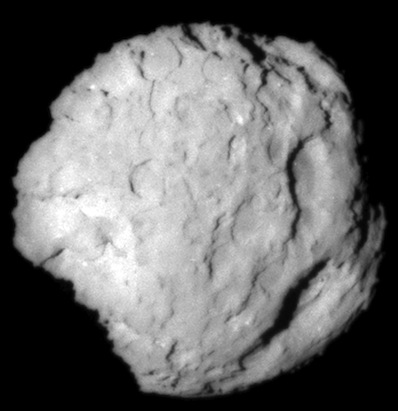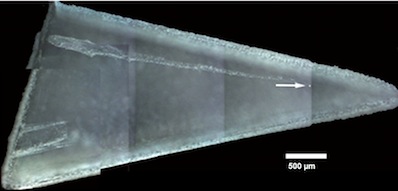
First evidence of space weathering on Comet Wild 2
DR EMILY BALDWIN
ASTRONOMY NOW
Posted: 28 March 2012


The presence of iron in samples collected from Comet Wild 2 by the Stardust mission and returned to Earth in 2006 have been interpreted as evidence for space weathering, giving the comet its rust-red hue.

A close-up of the nucleus of Comet Wild 2. Image: NASA/JPL.
Less than a milligram of pristine comet grains were scooped up in a silicon-based foam called aerogel, which slowed the particles from speeds of six kilometres per second to a halt over a space of a few millimetres. Since the safe return of the precious material, the particles and the tracks they left in the aerogel have been analysed by scientists all over the world. UK scientist John Bridges from the University of Leicester and colleagues used the Diamond Light Source synchrotron in Oxfordshire and at Leicester University to determine the mineral content of the samples.
“There’s definitely been a lot of high temperature processing going on, which we weren’t really expecting for a comet,” Bridges told attendees of the National Astronomy Meeting yesterday. “The particles are chondritic, rather like what we find in asteroids, compared with the typically “fluffy” material usually associated with comets.”

Aerogel sample of a track (track number 170) showing evidence for space weathering. Image: Bridges/University of Leicester.
Fragments of aluminium-rich chrondules – melt droplets that formed at 1,200 degrees Celsius – are helping to test models of Solar System formation that need to account for the presence of high-temperature, chemically processed material in the comet-forming region.
The scientists also think that bombardment of micrometeoritic debris and solar wind particles – space weathering – over the comet’s 4.5 billion year history is responsible for depositing nanometre-sized grains of iron on the comet and reddening its surface.
“These findings will likely change our views of comets and this could be the real legacy of Stardust,” says Bridges.
|



